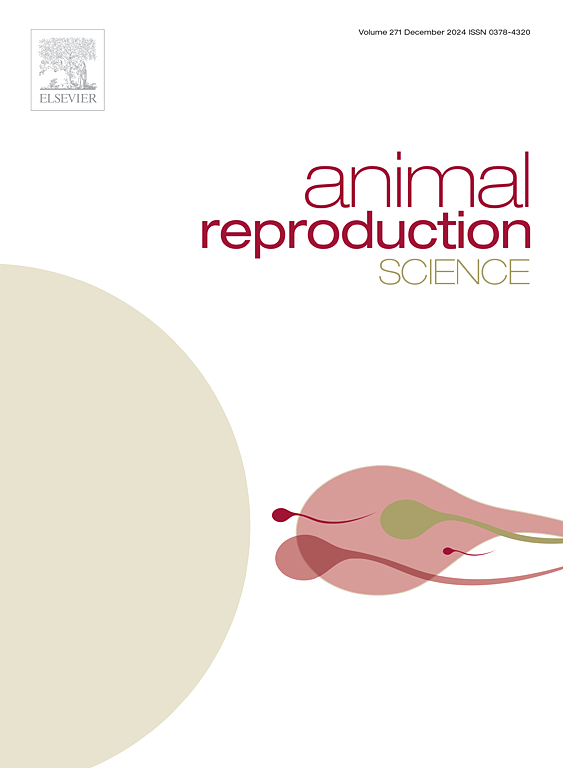CSTB对绵羊卵母细胞体外成熟的影响
IF 2.2
2区 农林科学
Q1 AGRICULTURE, DAIRY & ANIMAL SCIENCE
引用次数: 0
摘要
胱抑素B (Cystatin B, CSTB)主要作为细胞内半胱氨酸组织蛋白酶抑制剂,在多种组织中发挥重要的生物学功能。本研究旨在探讨CSTB在绵羊卵巢中的表达及其对绵羊卵母细胞体外成熟的影响。我们克隆了一个390 bp的CSTB cDNA片段,包含297 bp的编码序列,编码98个氨基酸。绵羊CSTB同源物的氨基酸序列与其他物种相似度为72.45 ~ 98.98 %。此外,CSTB在生殖系统的卵巢和子宫中高度表达,特异性定位于颗粒细胞和卵母细胞中。体外成熟培养基中加入重组CSTB可提高小卵泡卵母细胞的成熟率、卵裂率和囊胚率。相反,干扰CSTB敲低会降低卵母细胞的成熟率和发育潜力。重组蛋白上调卵母细胞线粒体膜电位、ATP和自噬蛋白LC3A/LC3B,下调活性氧。相比之下,CSTB敲低逆转了这些趋势,导致膜电位、ATP和LC3A/LC3B显著下调,活性氧上调。综上所述,CSTB是绵羊卵母细胞体外成熟的关键功能分子。它通过调节羊卵母细胞的活性氧(ROS)、膜电位和自噬来调节卵母细胞的发育潜能。这些发现增强了对CSTB在绵羊卵母细胞体外成熟中的作用的理解。本文章由计算机程序翻译,如有差异,请以英文原文为准。
Effects of CSTB on in vitro maturation of ovine oocytes
Cystatin B (CSTB) primarily acts as an intracellular cysteine cathepsin inhibitor and plays important biological functions in multiple tissues. This study aimed to investigate the expression of CSTB in ovine ovaries and its effect on the in vitro maturation of ovine oocytes. We cloned a 390 bp CSTB cDNA fragment, containing 297 bp coding sequence and encoding 98 amino acids. The amino acid sequence of the homologues of ovine CSTB is 72.45–98.98 % similar to other species. In addition, CSTB is highly expressed in the ovary and uterus of the reproductive system, specifically localized in granulosa cells and oocytes. Adding recombinant CSTB to in vitro maturation medium increased the maturation rate, cleavage rate and blastocyst rate of small follicle oocytes. Conversely, interfering with CSTB knockdown reduced the maturation rate and developmental potential of oocytes. Recombinant protein upregulated mitochondrial membrane potential, ATP, and autophagy protein LC3A/LC3B in oocytes while downregulated reactive oxygen species. In contrast, CSTB knockdown reversed these trends, resulting in significant downregulation of membrane potential, ATP, and LC3A/LC3B and upregulation of reactive oxygen species. In conclusion, CSTB is a critical functional molecule for the in vitro maturation of ovine oocytes. It regulates oocyte developmental potential by modulating reactive oxygen species (ROS), membrane potential and autophagy in ovine oocytes. These findings enhance the understanding of the role of CSTB in ovine oocyte maturation in vitro.
求助全文
通过发布文献求助,成功后即可免费获取论文全文。
去求助
来源期刊

Animal Reproduction Science
农林科学-奶制品与动物科学
CiteScore
4.50
自引率
9.10%
发文量
136
审稿时长
54 days
期刊介绍:
Animal Reproduction Science publishes results from studies relating to reproduction and fertility in animals. This includes both fundamental research and applied studies, including management practices that increase our understanding of the biology and manipulation of reproduction. Manuscripts should go into depth in the mechanisms involved in the research reported, rather than a give a mere description of findings. The focus is on animals that are useful to humans including food- and fibre-producing; companion/recreational; captive; and endangered species including zoo animals, but excluding laboratory animals unless the results of the study provide new information that impacts the basic understanding of the biology or manipulation of reproduction.
The journal''s scope includes the study of reproductive physiology and endocrinology, reproductive cycles, natural and artificial control of reproduction, preservation and use of gametes and embryos, pregnancy and parturition, infertility and sterility, diagnostic and therapeutic techniques.
The Editorial Board of Animal Reproduction Science has decided not to publish papers in which there is an exclusive examination of the in vitro development of oocytes and embryos; however, there will be consideration of papers that include in vitro studies where the source of the oocytes and/or development of the embryos beyond the blastocyst stage is part of the experimental design.
 求助内容:
求助内容: 应助结果提醒方式:
应助结果提醒方式:


